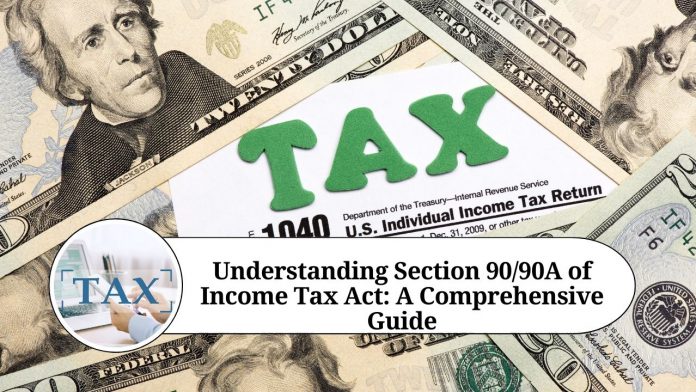Section 90 and 90A of the Income Tax Act: An Overview
The Income Tax Act is a comprehensive legislation that governs the taxation of income in India. It provides for various provisions that enable taxpayers to manage their tax liability efficiently. One such provision is Section 90 and 90A of the Income Tax Act. In this blog, we will take a closer look at these sections and understand their significance in the Indian tax system.
What is Section 90 of the Income Tax Act?
Section 90 of the Income Tax Act deals with the concept of Double Taxation Relief (DTR). DTR is a relief provided to taxpayers who pay taxes on the same income in two different countries. This can happen when a taxpayer earns income in a foreign country and is also liable to pay taxes on the same income in India. In such cases, DTR ensures that the taxpayer does not end up paying taxes twice on the same income.
Under Section 90, taxpayers can claim relief from double taxation in two ways:
- By way of an agreement between the Indian government and the foreign government
- By way of unilateral relief
The first method involves the signing of an agreement between the Indian government and the foreign government. This agreement is commonly known as a Double Taxation Avoidance Agreement (DTAA). The DTAA ensures that taxpayers who earn income in both countries do not end up paying taxes twice on the same income.
The second method of relief is called unilateral relief. In this case, relief is granted by the Indian government to taxpayers who have paid taxes on their foreign income in the foreign country. This relief is granted to ensure that taxpayers do not end up paying taxes twice on the same income.
What is Section 90A of the Income Tax Act?
Section 90A of the Income Tax Act deals with the concept of Advance Pricing Agreements (APA). APAs are agreements entered into between taxpayers and tax authorities to determine the transfer pricing methodology for transactions between associated enterprises. APAs provide taxpayers with certainty on the pricing of their cross-border transactions and help them avoid disputes with tax authorities.
Under Section 90A, taxpayers can enter into two types of APAs:
- Unilateral APA: This type of APA is entered into between the taxpayer and the Indian tax authorities.
- Bilateral APA: This type of APA is entered into between the taxpayer, the Indian tax authorities, and the tax authorities of the foreign country.
The APA process involves the submission of an application by the taxpayer to the tax authorities. The application includes details of the taxpayer’s business, the proposed transaction, and the transfer pricing methodology. The tax authorities then review the application and may conduct an audit to verify the details provided by the taxpayer. If the tax authorities are satisfied with the details provided, they may enter into an APA with the taxpayer.
Conclusion
Section 90 and 90A of the Income Tax Act are crucial provisions that provide relief to taxpayers who earn income in foreign countries or engage in cross-border transactions. These provisions ensure that taxpayers do not end up paying taxes twice on the same income and provide them with certainty on the pricing of their cross-border transactions. As businesses become more globalized, these provisions are becoming increasingly important for taxpayers to manage their tax liabilities effectively.
Other Related Blogs: Section 144B Income Tax Act
Frequently Asked Questions (FAQs)
Q. What is income tax? Income tax is a tax levied by the government on the income earned by individuals, firms, and companies in India. The tax is calculated as a percentage of the income earned and varies depending on the income slab.
Q. Who is required to pay income tax? Any individual, firm, or company that earns income in India is required to pay income tax. The tax liability varies depending on the income earned and the applicable tax rates.
Q. How is income tax calculated? Income tax is calculated as a percentage of the income earned by an individual or entity. The tax rates vary depending on the income slab and the applicable tax laws.
Q. What are the different types of taxes in India? In addition to income tax, the other types of taxes in India include Goods and Services Tax (GST), Corporate Tax, Excise Duty, Customs Duty, and Wealth Tax.
Q. What is a tax deduction? A tax deduction is an amount that can be subtracted from the total taxable income to reduce the tax liability. Some examples of tax deductions include investments in certain financial instruments, donations to charitable organizations, and payments for medical insurance.
Q. What is a tax credit? A tax credit is an amount that can be deducted directly from the tax liability. Some examples of tax credits include taxes paid in advance, taxes paid on foreign income, and taxes paid on property.
Q. What is a tax return? A tax return is a form that must be filed by individuals and entities with the tax authorities to report their income and tax liability for a particular financial year. The tax return must be filed by the due date specified by the tax authorities.
Q. What is a tax audit? A tax audit is an examination of the taxpayer’s accounts and financial statements by the tax authorities to verify the accuracy of the income and tax liability reported in the tax return. Tax audits can be conducted either randomly or based on specific criteria specified by the tax authorities.
Q. What is double taxation relief? Double taxation relief is a provision in the income tax laws that provides relief to taxpayers who earn income in two different countries and are liable to pay taxes on the same income in both countries. The relief can be granted either through a bilateral tax treaty between the two countries or through unilateral relief provided by the government of the country where the taxpayer is resident.
Q. What is an advance pricing agreement? An advance pricing agreement is an agreement between the taxpayer and the tax authorities that determines the transfer pricing methodology for transactions between associated enterprises. The agreement provides certainty to the taxpayer on the pricing of their cross-border transactions and helps avoid disputes with the tax authorities.




















